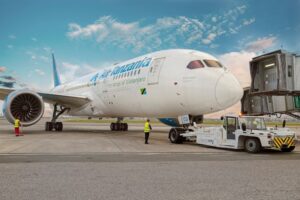Kenya on Tuesday unveiled the candidature of its former Prime Minister Raila Odinga for chairperson of the African Union Commission (AUC) at a colourful ceremony graced by several East African Community (EAC) heads of State.
President William Ruto led the launch at State House, Nairobi, where he hosted East African Community (EAC) Chairman Salva Kiir Mayardit, who is also the president of South Sudan, Presidents Samia Suluhu Hassan (Tanzania) and Yoweri Museveni of Uganda.

Tanzanian President Samia Suluhu Hassan is greeted by President William Ruto after delivering her speech during the launch of Kenyan candidate Raila Odinga’s bid for the African Union Commission (AU) chairmanship at State House Nairobi on August 27, 2024. Francis Nderitu | Nation Media Group
Also in attendance were Burundi Prime Minister Gervais Ndirakobuca, Rwanda State Minister for Foreign Affairs James Kabarebe, former Tanzania President Jakaya Kikwete and his Nigeria counterpart Olusegun Obasanjo, among other dignitaries.
Read: EAC leaders in Nairobi for Raila AUC bid launch
Speaking at the event, Dr Ruto said Mr Odinga enjoys a positive reputation as a zealous Pan-African who has consistently demonstrated strong faith in Africa’s possibilities, and exemplary commitment to the cause of laying a robust foundation for Africa’s transformation.
The head of State showered Mr Odinga with praises, noting that he is the best candidate for the position and that he would do all it takes to make him win the February 2025 election.
“I know that Raila Odinga not only possesses the requisite credentials but he is also the ideal candidate to lead the AUC. Accordingly, Kenya endorses his candidature unreservedly and we commit wholeheartedly to support his candidature, vision and leadership,” he said.
“Mr Odinga’s remarkable leadership and exemplary career make him a perfect fit to sit at the helm of the AUC and drive Africa’s transformation and Agenda 2063. He is an ardent champion of African unity, African Integration, infrastructural connectivity and youth empowerment.”
Mr Odinga’s strategic focus, he said, is to harness Africa’s rich and vast human and natural resources for the benefit of Africa’s peoples— making him the “optimal choice” for this position.
“I therefore welcome the continent to rally behind Mr Odinga’s candidature to propel Africa to sustainable peace and a new era of shared prosperity.”

Kenyan candidate for the African Union Commission chairmanship, Raila Odinga, speaks during the launch of his bid at State House Nairobi on August 27, 2024. Francis Nderitu | Nation Media Group
Campaign secretariat
During the State House event, Dr Ruto launched Mr Odinga’s campaign secretariat, which will be jointly led by Foreign Affairs Principal Secretary Korir Sing’oei and former US Ambassador to the United States Elkanah Odembo.
Mr Odinga said that he was ready to serve Africa.
“My heart is ready, my hands are steady and with your support, I shall get the opportunity to be of service to Africa, the cradle of mankind. I am made in Eastern Africa for Africa,” he said.
He exuded confidence that he would win the seat in the first round of the elections.
Mr Odinga will contest against Djibouti Foreign Minister Mahmoud Ali Youssouf, former Mauritius Foreign Minister Anil Kumarsingh Gayan and Richard James Randriamandrato, a former Madagascar Foreign Minister.
Read: Youssouf: My pledge to Africa as AUC chair
Mr Odinga pledged to push for scrapping of visa for intra-Africa travel and removal of trade barriers as he spelled out his vision of a united continent characterised by peace and prosperity for all.
“As a lifelong Pan-Africanist, I will offer participatory leadership to ensure delivery on the priorities of the African people as envisioned in the African Union Agenda 2063,” he said.
“This is Africa’s century… We must harness our vast human and natural resources, and integrate the energy of our youth with the vision and wisdom of our leaders.”
Read: AUC top seat contenders face age-old problems
He added: “Kindly buy my vision, the charge is 34 plus votes in the first round. I particularly appeal to fellow East Africans, that we walk this journey together and go to Addis as a team in February 2025.”
Kenya’s Deputy President Rigathi Gachagua, an arch-rival of Mr Odinga on Kenya’s political scene, described the launch as a “great moment for our country.”
“We are here to unveil Kenya’s finest to go and lead Africa. The people of Kenya have been united behind Raila to be AUC chair and Africa, our motherland deserves the best,” he said.
Read: Odinga AU ambitions halt his local moves
President Suluhu lauded Mr Odinga, saying “he is not only a wise statesman but one who can make a strong case for Africa”.
“With Raila Odinga, we envision an ever strong and growing Africa and the Republic of Tanzania assures Kenya of its for support. Tanzania says Baba anatosha achaguliwe (Raila fits the bill and should be elected).”

South Sudan President Salva Kiir arrives at State House Nairobi for the launch Kenyan candidate Raila Odinga’s bid for the African Union Commission (AU) chairmanship on August 27, 2024. Francis Nderitu | Nation Media Group
President Kiir said his presence in the country was to confirm South Sudan’s endorsement of Mr Odinga.
“As chairman of EAC, I strongly appeal to the region to rally behind Raila as the region’s candidate. Let us talk to our friends across the continent to enable Raila be the next chairman of African Union Commission,” he said.
Mr Museveni described Mr Odinga as a Pan-Africanist who is not just a job seeker but qualified for the post.
“He is the one to lead us in that big battle for prosperity and is the candidate who is fit for this job,” he said.

Uganda’s President Yoweri Museveni speaks during the launch Raila Odinga’s bid for the African Union Commission (AU) chairmanship held at State House Nairobi on August 27, 2024. Francis Nderitu | Nation Media Group
He said he was glad that President Ruto, DP Gachagua and other Kenyan leaders had united for the sake of Mr Odinga’s candidacy.












